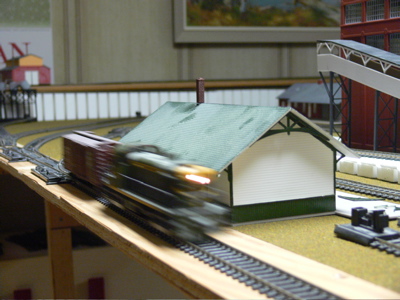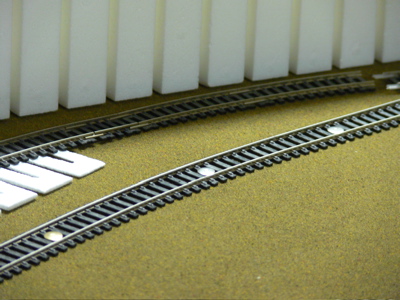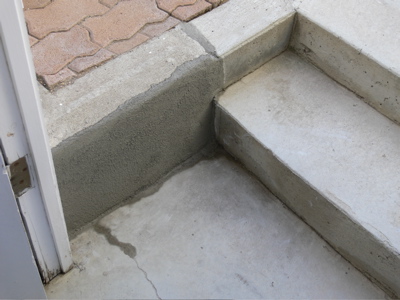 |
|
||||||||||||||
| Links to Notebook Pages: | Model Trains |
Literature |
Thursday July 13, 2006 6:20 am Lethbridge Alberta
A. Morning Musings
6:20 am
The temperature is currently 16 C with a high forecast of 23 C. It is fairly windy this morning. The forecast for the next 5 days is for lots of sunshine and temperatures in the high 20s.
I have added a few more relatively small chores to my list of tasks to keep in mind. I will parge the area around the rear step this morning.
Looking at the items I have identified as requiring Immediate attention (i.e. today), I consider the Model Trains as being the top one.
B. Plan
Immediate Chores Parge area around rear step to garage 1 hr Remove weeds from front lawn 1 hr Health Walk & exercise 1 hr Technology Make notes for chap. 3 of "Switching to the Mac" 1 hr Model Trains Fasten lower mainline track to layout 2 hr Literature Continue reading "Grizzly Lies" 1 hr Later Chores Take cement blocks to landfill 2 hr Fill cement cracks in garage floor 2 hr Fill mortar cracks in brickwork near garage front door 1 hr test saw blade for cutting 3/4" plywood (for book boxes project) 1 hr Investigate water softeners for home 2 hr Build 4 more book boxes Technology Read manual for cell phone 1 hr digital photography try using extender lens and monopod 2 hr Mathematics Larson "Calculus" Read "The Computational Beauty of Nature" Chap 2 1 hr Gardner "The Colossal Book of Short Puzzles" History Continue reading "Citizens" Watson "Ideas" Model Trains Add blue backdrop to layout 2 hr Review layout for under the table turnouts Purchase an NRMA gauge and some terminal blocks while in Edmonton Wire lower mainline track for a power block
C. Actual/Notes
7:30 am Before beginning work on laying track on my layout, I want to highlight a few points on the topic from "Trackwork and Lineside Detail for Your Model Railroad" by Kent Johnson. These are taken from the first chapter "Flexible Trackwork" by Jim Hediger.
- "Building reliable model railroad track doesn't take a lot of expertise or fancy tools, but it does require care and patience." [p. 4]
This is worth remembering. Slow. Slow. Slow.
- "... most modelers choose flextrack when they begin building a permanent layout." [p. 4]
I should give more attention to this. This would reduce the number of connections and improve overall conductivity and performance. This is particularly important on the mainline where most of the movement occurs.
- "... it's best to fit the track components together first and then mark the appropriate center lines between the ties. Then lay the roadbed." [p. 5]
I am doing this. I need to identify major sections and ensure that all the track is exactly where I want it in a section before I glue the roadbed to the table surface.
- "Start at a group of switches or a crossing where several different track alignments come together and then work out in all directions..." [p. 5]
- "As you join the track sections, lean down and sight along the rails to check the alignment at the joints." [p. 5]
I think it also makes sense to use a strait edge to check the alignment.
- "Test-fit each track section and trim it to fit. ... Cutting leaves a small burr that interferes with the rail joiner slipping on easily. Smooth the cut rail ends with a file before you add the joiners." [p. 5]
Before glueing down the roadbed I should also check to see if I want to insert any uncoupling magnets on the roadbed. This is not likely on the mainline track but is essential on the sidings and switching yards. Here is another quote from the third chapter "Railroading Without Derailments", also by Jim Hediger.
- "The key is to maintain good alignment through the rail joints. You need a smooth path for the wheels to follow, so make sure the tops and inside faces match perfectly." [p. 7]
8:10 am
12:20 PM I have tentatively tacked down the Lower mainline track. I replaced much of the sectional track with 3' lengths of flexitrack. I was impressed at how much more gradual, and realistic, I could make the curves. I now have a little cutting to do to bring the two tracks back to the same length at the end (since the inner track on a curve uses less length than the outer track). This is also the first time I used tacks to fasten the track. Paul mentioned this trick at the Lethbridge Model Train Society meeting a couple of weeks ago. At the moment I am using brightly colored plastic tacks which make it very easy to see which track is the mainline. Now I want to see if I can find some regular thumb tacks and see if I can run a locomotive over them. That would make it possible to really test the track before committing to the positioning. Once again, I am pleased with the result so far. This took about an hour to complete.
7:50 PM I have been down playing with the layout for the last hour. I finally located some thumb tacks and exchanged these for the plastic tacks I had been using to fasten the track to the plywood. It worked like a charm. I cut one piece of curved flextrack and then hooked everything together and added the power. The locomotive ran around the Lower Mainline loop like a charm. Perfect. After watching it for about 15 minutes I finally shut everything down and came upstairs to complete this report.
Here are a few photos:
I originally thought that I would immediately continue with making the Lower Mainline track layout permanent, but I now think I will run trains on it for a few days and see if any problems emerge. However I might work on the reversing loop section of the Lower Mainline and see if I can get that working. Another option will be add another half dozen to a dozen cars to the train consist and see how it behaves. A third option is to work a bit on some of the structures. And a fourth option is to begin wiring the 11 turnouts on the Lower mainline. But before I do this latter option I want to review the status of the turnouts and see if some of them can be replaced with an under the table mechanism.
11:10 am The chores are finished for today: weeds were removed from the front lawn and the purging of the rear step to the garage has been completed. Dandelions are a fascinating plant. Where the lawn is mowed regularly the plant is small and lies very low to the ground. But on the side of the house where we have some ivy growing there was a dandelion that had managed to force its way through the undergrowth and it rose another two feet above the surrounding plants. The leaves looked more like rhubarb than a dandelion. Amazing.
I now have most of the afternoon to play with my model train layout.
8:00 PM Here are three photos that add a little to my earlier comments over the last few days:
D. Reflection






